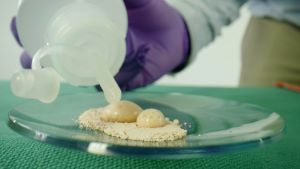New fizz test guidance to help rapidly identify on-farm lime
New fizz test guidance to help rapidly identify on-farm lime
Date: 15 Mar 2022

Western Australian growers can access new guidance for conducting on-farm lime tests, or ‘fizz tests’, to identify potential lime sources more quickly and precisely.
The new online tools, including a video and step-by-step methodology, are a result of a Grains Research and Development Corporation (GRDC) investment, which engaged a team of researchers from GHD to explore technologies with potential to rapidly identify on-farm lime sources.
GRDC Grower Relations Manager Jo Wheeler said that the need for an improved in-paddock testing method to identify on-farm lime sources efficiently and accurately was identified by growers specifically in the Kwinana East Port Zone of WA.
“Regular surveys have revealed seventy per cent of soils in south-west Western Australia are acidic. Lime is applied by growers to neutralise acidic soils and improve growing conditions for crop production,” said Ms Wheeler.
“It’s often sourced from coastal regions, but transport costs further inland can make this expensive. To reduce this cost, growers in some regions have been able to identify soils on their properties that contain carbonates.”
Dr Clare Engelke, GHD’s project leader for the research, said an extensive desktop review of technologies and economic analysis was completed, with several of the technologies showing promise. However, none of the technologies were time-effective, which was one of the priorities for the project.
“This outcome prompted us to focus our efforts on investigating the value in improving and standardising how growers complete field-based ‘fizz tests’”, Dr Engelke said.
The ‘fizz test’ involves adding acid to a soil sample and observing the level of fizz that results. The test can be used on farm to determine the presence of carbonates in soil, and is fast, easy and cheap.
It provides growers with an initial screening tool to rapidly assess their soils for potential neutralizing value and evaluate if further investigation is warranted.
“Anecdotally, we determined that growers are using a variety of acids and techniques. However, analysis of the project data indicated that if growers were to use the same method and compare results in a shared database, they could potentially improve the power and reliability of the fizz test method.”
In the long term, with a sufficient data set and statistical analysis, growers may be able to use their fizz test results to estimate effective neutralising value.
As part of the GRDC-funded project, GHD is seeking an additional 60 soil samples for assessment by fizz test and laboratory analysis. Samples should be from the Kwinana East Port Zone and from locations that growers consider to be potential sources of on farm lime, based on assessment using the new online tools.
Ms Wheeler said that with improved on-farm testing methodologies, growers would be able to target potential on-farm lime sources more accurately.
“This could reduce costs for growers because fewer samples will require lab testing,” Ms Wheeler said.
Laboratory testing would still be required to confirm effective neutralising value and to determine the presence of any contaminants that could pose problems if spread across paddocks.
GHD has recorded a demonstration video of the “fizz test” method that can be can be used to complete on farm assessment of potential lime sources, and produced a complementary written method, adapted for use on-farm. More information is available in GRDC’s Groundcover online.
Growers are encouraged to contact Clare Engelke, Senior Agricultural Scientist, GHD Geraldton on 08 9920 9413 to submit a soil sample.
Contact details
Interviews
Jo Wheeler, GRDC
0438 292 167
Jo.wheeler@grdc.com.au
Contact
Danielle Gault, GRDC
0448 766 881
danielle.gault@grdc.com.au
GRDC Project Code: GHD2003-001SAX,
